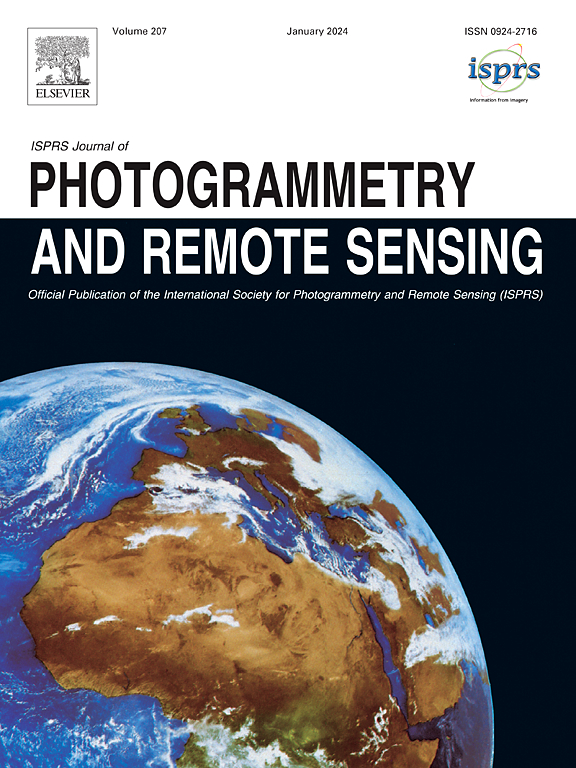A cross-spatiotemporal weakly supervised framework for land cover classification: Generating temporally and spatially consistent land cover maps
IF 10.6
1区 地球科学
Q1 GEOGRAPHY, PHYSICAL
ISPRS Journal of Photogrammetry and Remote Sensing
Pub Date : 2025-07-01
DOI:10.1016/j.isprsjprs.2025.06.005
引用次数: 0
Abstract
High-resolution land cover mapping tasks guided by publicly available decameter-level land cover products often suffer from label inaccuracies caused by land cover changes and scale discrepancies resulting from spatiotemporal resolution inconsistencies. To address this issue, this study proposes a cross-spatiotemporal weakly supervised dual-stage classification framework (CTS-WS) that implements temporal and spatial correction strategies to rectify erroneous labels and scale differences, achieving spatiotemporal consistent high-resolution land cover mapping. In the cross-temporal stage, we establish an NDVI screening and uncertainty noise correction mechanism by leveraging the spectral characteristics of high-resolution imagery and the feature fitting capability of convolutional neural networks, effectively eliminating pixels with spectral feature mismatches. The cross-spatial stage proposes a dual-branch parallel network integrating spatial and spectral features, which combines a periodic label screening module with boundary metric loss to learn fine-grained spatial features and refine boundaries. To validate the effectiveness of the proposed method, this study constructed the GF1-CTS dataset by integrating Gaofen-1 satellite imagery with ESA-GLC10 product, and conducted parallel experiments on both the GF1-CTS dataset and a large-scale Chesapeake Bay watershed dataset. Experimental results demonstrate that CTS-WS successfully achieves cross-spatiotemporal resolution land cover mapping from 10 m to 2 m and from 30 m to 1 m, outperforming various mainstream methods and state-of-the-art technologies. This study provides a novel solution for high-resolution remote sensing image land cover mapping across spatiotemporal resolutions.
土地覆盖分类的跨时空弱监督框架:生成时空一致的土地覆盖图
以公开的十米级土地覆盖产品为指导的高分辨率土地覆盖制图任务往往存在由于土地覆盖变化导致的标签不准确和由于时空分辨率不一致导致的尺度差异。为了解决这一问题,本研究提出了一个跨时空弱监督双阶段分类框架(CTS-WS),该框架采用时空校正策略来纠正错误标签和尺度差异,实现了时空一致的高分辨率土地覆盖制图。在跨时间阶段,我们利用高分辨率图像的光谱特征和卷积神经网络的特征拟合能力,建立了NDVI筛选和不确定性噪声校正机制,有效地消除了光谱特征不匹配的像元。跨空间阶段提出了空间特征与光谱特征相结合的双分支并行网络,将周期标签筛选模块与边界度量损失相结合,学习细粒度空间特征,细化边界。为了验证该方法的有效性,本研究将高分一号卫星影像与ESA-GLC10产品整合,构建了GF1-CTS数据集,并在GF1-CTS数据集和切萨皮克湾大尺度流域数据集上进行了并行实验。实验结果表明,CTS-WS成功实现了10 ~ 2 m和30 ~ 1 m的跨时空分辨率土地覆盖制图,优于各种主流方法和最新技术。该研究为高分辨率遥感影像土地覆盖制图提供了一种新的解决方案。
本文章由计算机程序翻译,如有差异,请以英文原文为准。
求助全文
约1分钟内获得全文
求助全文
来源期刊

ISPRS Journal of Photogrammetry and Remote Sensing
工程技术-成像科学与照相技术
CiteScore
21.00
自引率
6.30%
发文量
273
审稿时长
40 days
期刊介绍:
The ISPRS Journal of Photogrammetry and Remote Sensing (P&RS) serves as the official journal of the International Society for Photogrammetry and Remote Sensing (ISPRS). It acts as a platform for scientists and professionals worldwide who are involved in various disciplines that utilize photogrammetry, remote sensing, spatial information systems, computer vision, and related fields. The journal aims to facilitate communication and dissemination of advancements in these disciplines, while also acting as a comprehensive source of reference and archive.
P&RS endeavors to publish high-quality, peer-reviewed research papers that are preferably original and have not been published before. These papers can cover scientific/research, technological development, or application/practical aspects. Additionally, the journal welcomes papers that are based on presentations from ISPRS meetings, as long as they are considered significant contributions to the aforementioned fields.
In particular, P&RS encourages the submission of papers that are of broad scientific interest, showcase innovative applications (especially in emerging fields), have an interdisciplinary focus, discuss topics that have received limited attention in P&RS or related journals, or explore new directions in scientific or professional realms. It is preferred that theoretical papers include practical applications, while papers focusing on systems and applications should include a theoretical background.
 求助内容:
求助内容: 应助结果提醒方式:
应助结果提醒方式:


